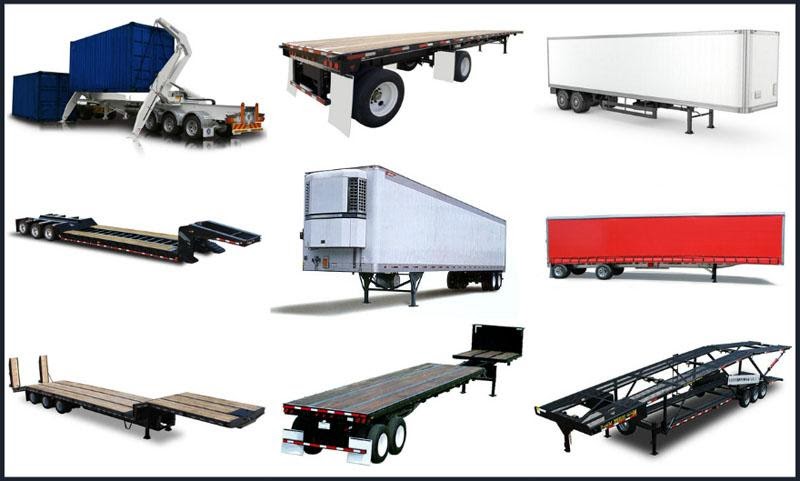
Today, more than 80% of freight is transported by trucks, creating millions of jobs for the business. Trailers are an extra carrier vehicle you see attached to the back of the truck while driving on the highway. There are many types of trailers, each having a different capacity and a different purpose depending on the goods being transported.
A trailer is mobile due to the wheels it has, but cannot run alone as it has no engine, which means it needs a truck with an engine to be useful. To select the right trailer for the job depends on the type of load that needs to be carried. For example, if you must transport frozen goods, then a refrigerated trailer would be the one to pick. Each trailer is unique for the freight it is carrying. Today we will help you decide which trailer is best for you or just educate you on what’s out there!
Flatbed Trailer
The flatbed trailer has an open deck with no sides and no roof. This trailer is usually used for relocating industrial products. Flatbeds are more popular than others because of the many types of uses this trailer provides. It is very basic, with no sides or roof, providing quick and easy loading and unloading.
Open deck equipment is the most flexible with loading/unloading.
Items shipped using this trailer include: Large equipment, building materials, and large machinery:
- Maximum legal trailer length: 48 ft – 53 ft.
- Maximum legal trailer width: 8.5 ft.
- Maximum legal freight height: 8.5 ft.
- Maximum legal freight weight is: 48,000 pounds
Dry Van Trailers
Dry van trailers have a box shaped trailer, without temperature control. Most of the world’s cargo is moved by dry vans.
These trailers are fully enclosed and protected, but they do not have any form of temperature control. That is why dry vans are used for moving goods that are not temperature-sensitive. The only doors are at the rear, meaning they can only be loaded and unloaded with a forklift. A dock is required for loading and unloading these trailers. When a loading dock is not available, some trailers can come equipped with liftgates that can get your freight inside, and back outside.
Enclosed trailers are less expensive compared to other trailers.
Items shipped using this trailer include: Packaging, paper, dry grade food, beverages, plastics, clothing, building products, lawn/garden goods, chemicals, ink/paint, batteries, seeds, and finished products.
- Maximum legal trailer length: 48 ft – 53 ft.
- Maximum legal trailer Width: 8.2 ft.
- Maximum trailer height: 8 ft.
- Maximum legal freight weight is: 42,000 lbs to 45,000 lbs.
Refrigerated Trailer
Sometimes the material that needs to be moved must be kept at a cooler temperature.
A refrigerated trailer is a temperature-controlled unit. It is mostly used for moving chilled and frozen products. The temperature inside the trailer remains constant, no matter how extreme the weather outside is. Refrigerated trailers are unique and take additional fuel to keep the cooling mechanism running, making it more rare and expensive than standard equipment.
This trailer can only be loaded and unloaded from the rear using a forklift. As with the dry van trailer, a dock is required for loading and unloading.
Items shipped using this trailer include: Frozen foods, ice creams, and pharmaceuticals.
- Maximum legal trailer length: 48 ft – 53 ft.
- Maximum trailer legal width: 8.2 ft.
- Maximum legal trailer height: 8 ft.
- Maximum legal freight weight is: 42,000 to 45,000 lbs.
Step Deck Trailer
Step deck trailers are quite like flatbeds. The difference between the two is the maximum legal height. Flatbeds are about 5 feet off the ground, while a step deck trailer’s is closer to the ground, leaving more room to transport goods taller than 8 feet. They are used to move items that flatbeds are not able to move legally.
As the name implies, there are two deck levels, upper and lower. Ramps are used to unload goods. This makes it safer and easier for forklifts to unload, since they are closer to the ground.
Items shipped using this trailer include: Equipment, building materials, and machinery that are too large for flatbeds.
- Maximum legal trailer length: 48 ft – 53 ft.
- Maximum legal trailer width: 8.5 ft.
- Maximum legal freight height: 10 ft.
- Maximum legal weight for a Stepdeck is: 48,000 pounds.
Extendable Flatbed Trailer
The Extendable Flatbed Trailers are flatbeds that can increase their length. A 43 feet long flatbed can be extended to up to 80 feet long! These trailers are exactly like flatbeds, no walls or roof. These are used to carry anything that is too massive to fit inside a container.
When the trailer bed is extended, the pin connecting two sections is released and the brakes of the truck are pressed, which send the extended portion of the trailer bed outwards.
Shipped items include: lumber, construction materials, large beams, trusses, freight bigger than 100” height wise or exceeding 100” in width:
- Maximum legal trailer length: 48 ft – 80 ft.
- Maximum legal trailer width: 8.5 ft.
- Maximum legal freight height: 8.5 ft.
- Maximum legal freight weight of: 43,000 pounds.